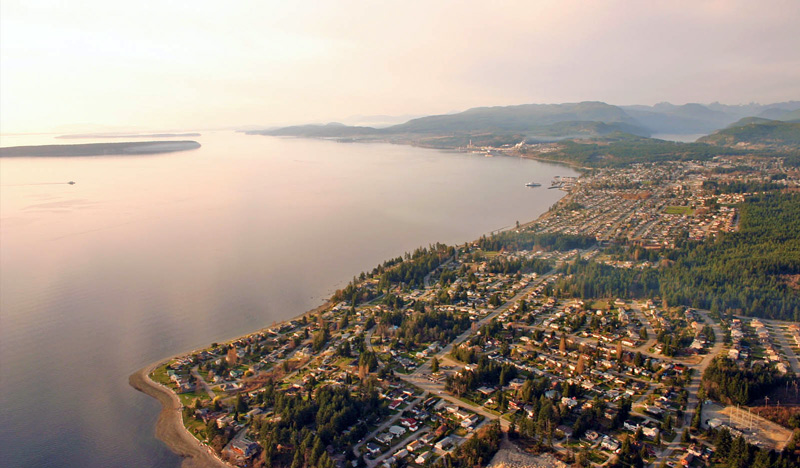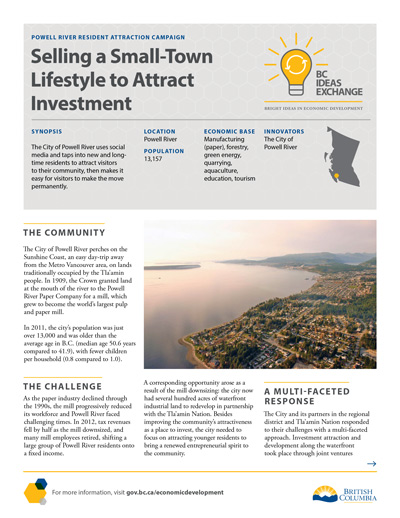Selling a Small-Town Lifestyle to Attract Entrepreneurs and Investment
Powell River
The City of Powell River perches on the Sunshine Coast, an easy day-trip away from the Metro Vancouver area, on lands traditionally occupied by the Tla’amin people. In 1909, the Crown granted land at the mouth of the river to the Powell River Paper Company for a mill, which grew to become the world’s largest pulp and paper mill. In 2011, the city’s population was just over 13,000 and was older than the average age in B.C. (median age 50.6 years compared to 41.9), with fewer children per household (0.8 compared to 1.0).
The Challenge

As the paper industry declined through the 1990s, the mill progressively reduced its workforce and Powell River faced challenging times. In 2012, tax revenues fell by half as the mill downsized, and many mill employees retired, shifting a large group of Powell River residents onto a fixed income.
A corresponding opportunity arose as a result of the mill downsizing: the city now had several hundred acres of waterfront industrial land to redevelop in partnership with the Tla’amin Nation. Besides improving the community’s attractiveness as a place to invest, the city needed to focus on attracting younger residents to bring a renewed entrepreneurial spirit to the community.
A Multi-Faceted Response
The City and its partners in the regional district and Tla’amin Nation responded to their challenges with a multi-faceted approach. Investment attraction and development along the waterfront took place through joint ventures with Catalyst Paper Corporation, the City of Powell River, and the Tla’amin Nation.
Community partners worked on improving the region’s investment environment with a wide range of capacity building projects in tourism; arts, culture and heritage; international education; and food production. The City of Powell River developed and launched a resident attraction campaign which has drawn a great deal of attention and continues to build momentum.
Transforming Visitors to Residents
The Powell River resident attraction campaign focuses on attracting young people and families to the community to telecommute, fill local job vacancies, or start new businesses.
The campaign uses social media, video profiles, a print brochure (in English and Mandarin), and a website that provides detailed information on the community. The social media tools are the real heart of the campaign’s activities, spanning Facebook, YouTube, Twitter, and Instagram.
The most important first step was to get residents and local organizations to use their social media networks to spread the message. The Facebook page now has over one thousand followers, and the almost-daily posts generate anywhere from 1,500 to 5,000 engagements.
The most popular pieces of the campaign are the video profiles of new residents. Having people who have migrated to the community tell their story is probably one of the most powerful messages.
Hard Work Paying Off
Besides the social media and video popularity, you can see evidence of the campaign’s success when you look at the city’s population and economy.
-
The 2016 census reported an increase in population for the regional district of 0.8%, although the city itself saw a 0.1% decrease as land in the surrounding electoral areas was developed.
-
According to statistics kept by the Powell River Real Estate Board, 64% of home sales in the first half of 2018 were for principal residences, with a 33% increase in the median selling price for residential single-family homes in 2018.
-
50% of properties sold were to out-of-town buyers in the last three years. Many buyers were from the Hope to Squamish corridor and around half were moving for job-related reasons.
-
The value of building permits for the city doubled from 2017 to 2018.
-
Enrollment in School District 47 has increased for three years, from 2,054 in 2016 to 2,278 in 2018.
-
The Public Health Unit reports a rise in the number of children under four years in the community.
-
Foreign interest in Powell River is increasing, with a newly opened shellfish hatchery owned by a Chinese seafood producer, and an international secondary school owned by Sino Bright Schools.
-
A land deal was recently completed with a Chinese company to build an Aviation Industrial Mall on an 11.5-acre parcel at the City’s airport.
Lessons Learned
-
Resident attraction campaigns get a huge boost with “buy-in” from residents using their personal social media networks to get the message out.
-
Development services need to be prepared to handle an influx of zoning and building permit applications coming from the incoming residents and investment.
-
Growth in population may not land where it’s expected, making it important for municipalities to work with their neighboring jurisdictions to coordinate services and infrastructure to meet broader community needs.
Population: 13,157
Region: Vancouver Island/Coast
Economic Base: Manufacturing (paper), forestry, green energy, quarrying, aquaculture, education, tourism
Download the full story (PDF, 341 KB)
Contact information
Scott Randolph,
Director of Economic Development & Communications
Powell River
604-485-8653


